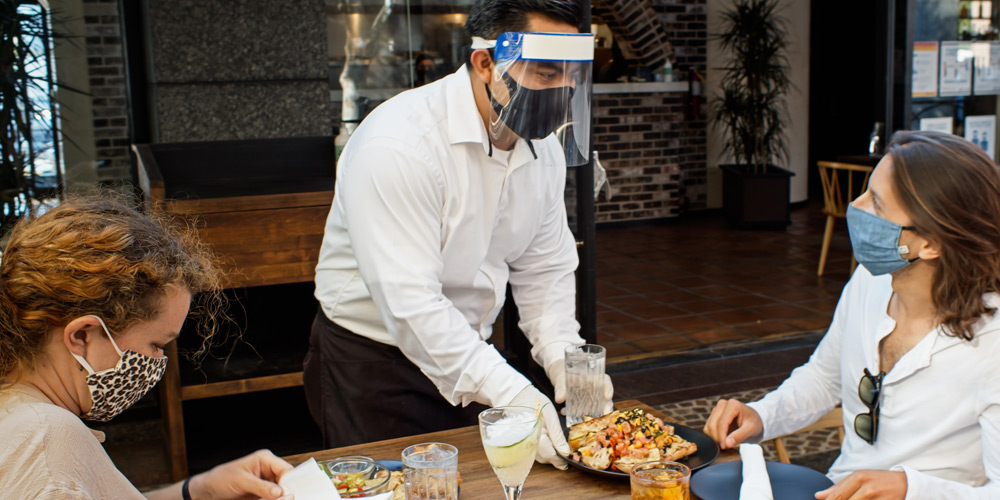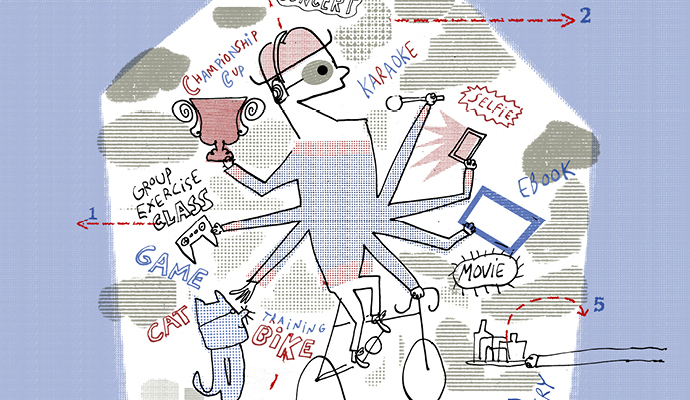Forget about the “new normal”: Design something different
Five principles of service design, adapted for the COVID-19 era.
As executives adjust to the realities of business during COVID-19, they often default to talking about the “new normal.” Although this phrase acknowledges that there will be differences — some of which customers have already experienced — it’s a blithe nod to the notion of coming back to something that begins to feel familiar. Sure, we now have curbside pickup, more video calls, and less actual contact between customers and those who serve them. But normal, new or otherwise, implies a degree of familiarity and stability that is impossible now and might be so for years. It gives an unrealistic expectation of comfort, and, as an unintended consequence, encourages people to close their eyes to new possibilities.
The reality is that we are in an era ruled by uncertainty. In one recent survey, more than 80 percent of business leaders said that they were likely to make significant and long-lasting changes in how they organized work and interacted with and served customers. Opportunities to redesign the business and do something substantially different usually come only after an event such as a merger or when a startup suddenly scales. But the wide-ranging effects of the coronavirus pandemic give all businesses the impetus for change.
How do you as a company leader design for this different world? When the ground shifts beneath you, the first thing to do is find a solid place to stand — and that is your value proposition. Customers come to you for a reason: because you’re innovative or top-quality, because you’re a one-stop shop, or because you build deep relationships. Yes, you need to both stress-test that value proposition and do a gut check on it, but in all likelihood, you’ll reaffirm it. Now is not the time to change it.
What might change, however, is how you deliver the value you promise, and that depends on five principles that translate a value proposition into the experience customers actually have. We first outlined these service design principles several years ago in “The art of customer delight.” Today, we use the acronym SPICE, because they involve segments (which customers you serve), promises (the expectations you set), innovation (how you evolve and improve), coherence (how you orchestrate sales channels and ecosystem partners), and efficiency (how you become easy to do business with). When you apply them in the context of the coronavirus pandemic, they may lead you to new and different insights about how to design your customers’ experience and employees’ activities.
1. Segment your customers. “The customer is always right” is one of the oldest and most misleading adages in business. The customer is always right only if you have the right customer. Has your “right customer” changed? Through no fault of yours, businesses you’ve worked with or customers whose needs you successfully met may have temporarily retreated or changed to a new model. How can you still be “right” for each other?
Consider Panera Bread — a fast-casual restaurant chain, meaning it’s a cut above fast food but is not at the level of waitstaff service. Panera’s value proposition emphasizes food made fresh from sustainably sourced ingredients. Its right customers have traditionally been office workers: individuals picking up a bagel and coffee for breakfast or meeting a colleague for lunch; groups for which it caters a selection of sandwiches and salads for meetings. That right customer is no longer in the same place; she is probably working from home now, and is likely to continue doing so at least some of the time for the foreseeable future. Lunch around the conference table? Well, maybe next year.
Must Panera resign itself to losing business as its customer changes her habits? Or can Panera redesign its offerings to find her in new places and meet her changed needs? Maybe so. The company now offers “family feast value meals” — the working lunch, but delivered to customers’ homes — and a grocery delivery or curbside pickup service selling breads, cheeses, and other items ordinarily used to prepare restaurant meals.
You might also find that your company has new right customers: These might be people or companies that have changed in ways that could benefit you if you design ways to connect with them, or that have been stranded by the incapacity of others, or that are worth your attention now although they weren’t before. Hertz, with cars sitting unrented, has stopped charging young drivers extra fees, and car rental services overall are shifting inventory away from airports to urban areas, where cars are now in greater demand.
You might find that your company has new ‘right customers’: people or companies that have changed in ways that could benefit you, if you can design ways to connect with them.
2. Promise what you can deliver. Companies need to set clear expectations and meet them every time. Rather than surprise and delight your customers, just delight them, by being clear and consistent. Here, too, the pandemic has played havoc with the best-planned customer experience. Take airline travel, for example. The airlines’ most profitable customers (first-class and business fliers) are used to pre-takeoff drinks, hot meals served on china dishes, and constant attention from smiling flight attendants.
Now, food and beverage service has been radically curtailed, interaction with flight attendants is minimized, and the overall experience of flying is more focused on enforcing safety measures than anticipating needs. So how to satisfy the flier who expects more for paying more? We could make a list of possibilities, from increasing mileage bonuses to adding limousine service to and from the airport. However, what’s really needed is not a list but a solution: clearly thought-through brand-appropriate expectations that together add up to something customers see as valuable.
American Express, for example, has offered to give its Platinum Card members (the equivalent of first-class customers) a $20 monthly credit toward both wireless phone service and streaming services, for six months. Think of them as staycation perks — a substitute for the travel-related benefits (such as access to airport lounges) that are Amex’s sweet spot, but that are less valuable today.
Companies also now have the opportunity to set and meet expectations in an area that businesses didn’t need to highlight before: safety and hygiene. Spotless subways, temperature checks for dental patients and salon customers, contactless payment, hand sanitizer in the lobbies of hotels and office buildings alike: These and other features can be the basis for a set of expectations to design into customer experience, and they capture the customer’s attention early in the overall interaction.
3. Rely on process innovation. Too often, companies think of innovation as something that comes out of a lab. But innovation can and should happen at every point of interaction between a company and its customers. Indeed, studies consistently show that process and business model innovation have higher average returns than product innovation, especially in larger companies.
A process and business model mindset is exactly what’s called for in the education industry, which accounts for more than 6 percent of GDP in the United States. From kindergarten to four-year colleges, educators are struggling with the challenge of delivering value — content, instruction, and camaraderie — when the old delivery model has been impaired. The solution won’t be found in new software products for remote learning — versions of those have been around for years, and they won’t help students who don’t have access to computers or reliable Internet. The solution will come instead from experimentation that combines elements of technology, social innovation, teaching, and collaboration.
For some industries, innovation might be as easy as adapting proven models from other countries or industries. In many U.S. states, restaurants restricted from offering indoor dining have spread out into the streets, to umbrella-covered bistro tables and tented, socially distanced tables. Urban landscapes blighted by scaffolding have been rendered atmospheric with decorative lights. Supportive city planners have closed streets partly or entirely to traffic — and tough luck for those who fled the city and will return to fewer parking spaces. The transformed dining experience “is as if the U.S. had discovered Europe,” one observer noted on social media.
4. Create a coherent experience. Companies need to be on-brand — to meet the expectations they set for the customer they want to serve — in every channel and at every touch point. But for many companies, the pandemic pulled apart experiences that once were cohesive. It has driven companies online, whether or not they wanted to operate there; it has attenuated people’s ability to deliver personal attention, whether they are lawyers or shopkeepers; it has made rips in seamless service.
Amid all the forces pulling against coherence, Best Buy has found a way to address the pandemic while becoming even more coherent than before. Along with the usual shopping safeguards (mandatory masks, limits on the number of customers, social distancing at checkout lines), Best Buy now offers customers the ability to book appointments for in-store sales consultations. That new feature of the sales process is a perfect match — a bookend for what the company already offered through its Geek Squad subsidiary, which offers in-store appointments and house calls to install and fix electronics. Best Buy now provides consultative sales and services throughout the customer journey.
5. Prioritize efficiency. For great customer experience to be sustainable, it needs to be efficient for both the provider and the customer. If it’s inefficient for the provider, it’s likely to be unprofitable. If it’s inefficient for customers, they will find someone else with whom it’s easier to do business. Efficiency was a casualty of the early days of the pandemic. Businesses were often working with reduced and dispersed staff. Customers understood and tolerated inconvenience out of loyalty or because they trusted the company. The grace period is ending.
Healthcare is an industry in which the search for efficiency has gained new urgency. Telemedicine — long promised as a cost control and time-saver — made a much-delayed debut at a variety of providers, ranging from local MDs to major hospital networks. In some cases, telehealth is as low tech as using FaceTime or Skype. “You can tell a lot about a patient’s overall manner, as well as a lot about specific symptoms, breathing, pallor, and their type of cough over a screen,” one primary care doctor confided.
This shift to telemedicine, many aspects of which will become permanent, is making medical care faster and easier for both patient and provider — and it needn’t be limited to routine care. Under a crush of coronavirus cases, Northwell Health, a major hospital group in the Northeast, created a treatment protocol to deliver advanced care to seriously ill patients at home, called “wraparound home care services,” via a combination of in-home assessments and regular telemedicine check-ins with pulmonologists. “On a dime we can get this up and running in huge numbers,” Northwell physician Gita Lisker recently told the New York Times, thus scaling up a new, highly efficient way to treat patients without the cost and administrative burden of hospitalization.
For Round 2 of the U.S. government’s Paycheck Protection Program (PPP), whose application deadline was June 30, 2020, the PPP found itself with some US$132 billion to disperse, in large part because inefficiencies had made it hard to get money to companies in Round 1. The government clarified eligibility, eased regulations, and opened up the playing field to allow smaller, more agile banks and fintechs to participate in the loan process. Cross River Bank — a single-branch bank in New Jersey, less than one-one-thousandth the size of JPMorgan Chase — was the number four processor of PPP loans by volume in the country as of the end of June.
Cumbersome documentation processes have long been an issue in commercial banking. Cross River’s success is an example of a broader trend in which banks of all sizes are using the pressure of the pandemic and the advances of fintech to reimagine those processes and make them easier for clients and more efficient for banks — hopefully resulting in changes that will last beyond the pandemic. And technology is not the only path to new efficiencies. Another could be as simple as empowering employees with more decision-making authority. It’s time to look at where you can reduce friction both internally and externally.
Many of the changes caused by the coronavirus will be inconvenient for a time. But they need not be inconvenient indefinitely; indeed, they cannot be. After 9/11, airport security became a dreaded part of travel. It was a decade before the U.S. Transportation Security Administration introduced TSA PreCheck, and even longer before U.S. airports invested in equipment to speed up the lines (which European airports did far earlier). Let that, and other examples of major events forcing change, be a lesson. Now is the time to redesign, to invest so you can serve your right customers, keep your promises, make innovation constant, improve coherence, and enhance efficiency. You’ll get a chance like this only once — we hope.






